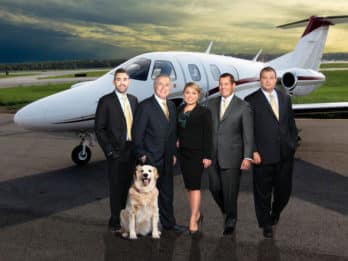N560AR CITATION 560XLS+ ACCIDENT AT PLAINVIEW CONNECTICUT LOOKS LIKE AN ABORTED TAKEOFF THAT WASN’T SUCCESSFULLY ACCOMPLISHED BECAUSE OF SUDDEN MECHANICAL FAILURE
N560AR CITATION 560XLS+ ACCIDENT AT PLAINVIEW CONNECTICUT LOOKS LIKE AN ABORTED TAKEOFF THAT WASN’T SUCCESSFULLY ACCOMPLISHED BECAUSE OF SUDDEN MECHANICAL FAILURE
This terrible accident is speculated the result of mechanical failure. There is no question about that. Cessna Citation 560XLS’s do not crash on takeoff on a clear day with two accomplished pilots aboard without something going terribly wrong. The airplane was not at gross weight, the runway while short was not too short for the takeoff but the balanced field length was about 300 feet longer than the existing runway. What that means is that at gross weight once the aircraft reaches V1, the speed at which engine failure results in continuing the takeoff, the airplane can be stopped on the remaining runway if it is 3900 feet long.
This airplane if the decision was made to abort the takeoff at or before V1, should have been able to stop on the remaining runway but that requires an immediate recognition of engine failure and an immediate decision to abort. All of this assumes engine failure which is very rare in today’s jet aircraft but possible. This aircraft has thrust reversers and perhaps one of them became unlocked or worse started to deploy. Bird strikes during the takeoff can wreak havoc with jet engines and many accidents have occurred due to reactions to that encounter.
Another possibility is a mechanical failure unrelated to the engines, like a control malfunction or jam when the crew attempted to rotate for takeoff which caused the crew to realize that continuing the flight was unsafe and a decision made to abort. That would have been a later made decision and would account for the lack of remaining runway to stop.
Aborting takeoffs is a leading cause of fatal accidents because on short runways a perfect response is required and perfection is usually a judgment call made by Monday morning quarterbacks when an airplane crash occurs.
This accident is eerily similar to another Cessna 560XL in 2019. That aircraft crashed when it couldn’t stop on the runway when the crew aborted the takeoff due to the controls not responding to them pulling back on the control yoke to takeoff. This Citation has a hydraulic actuator to move the leading edge of the horizontal stabilizer nose down when the flaps are extended for takeoff. If the stabilizer did not stop at 2 degrees nose down but went further, the crew wouldn’t know that the nose down stabilizer authority exceeded the ability of the elevators to rotate the nose. That would account for the later than usual abort command and the inability to stop on the remaining runway in both accidents. If The Wolk law Firm investigates this accident, that’s where we would first look, an overtravel of the horizontal stabilizer nose down.
A careful review of recent maintenance will be helpful in ascertaining the cause of this accident together with cockpit voice and data recorder analyses. Someone on this flight deck called out a malfunction and crew coordination would have called out the appropriate checklist if a memory item before impact.
I fly a twin-engine jet single pilot and when taking off on a short runway, I often think about what an abort would look like. No one wants it to look like this but there will be lessons learned at great cost because of the tragic loss of life.
Recently my airplane suffered hangar rash that no one owned up to or even mentioned to me before I discovered it on pre-flight. If someone backed this airplane up into a wall hitting the elevators damage to their function could have occurred that would not be visible on a preflight since the tail is so high.
There is also always the possibility of maintenance gone bad, some part that failed causing a warning or malfunction. Even a false warning like engine fire would be enough for any pilot to consider aborting the takeoff.
Hopefully the CVR or FDR will be undamaged as the tail looks like it was spared the fire destruction thus these components should be able to be read and some light shed on the cause.
For the families, their great loss will be aggravated by the NTSB’s insistence on not releasing the wreckage until it releases its report and probable cause determination. The NTSB will be “assisted” in its investigation by both Cessna and the engine maker so the chances of it coming up with an unbiased conclusion are nil in my experience.
The Wolk Law Firm regularly fights the NTSB in Court to gain access to and preserve critical evidence. We wait for no one.
Our condolences to these families who have lost so much. May the memories of their loved ones be a blessing.
Arthur Alan Wolk
9/3/21




